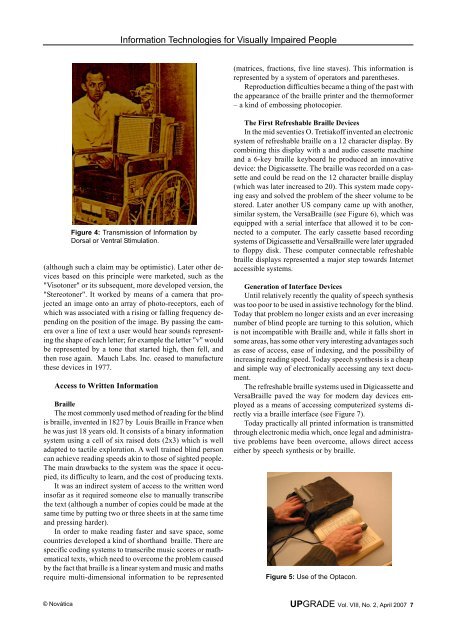Download full issue (PDF 2.1MB) - Council of European ...
Download full issue (PDF 2.1MB) - Council of European ...
Download full issue (PDF 2.1MB) - Council of European ...
You also want an ePaper? Increase the reach of your titles
YUMPU automatically turns print PDFs into web optimized ePapers that Google loves.
© Novática<br />
Information Technologies for Visually Impaired People<br />
Figure 4: Transmission <strong>of</strong> Information by<br />
Dorsal or Ventral Stimulation.<br />
(although such a claim may be optimistic). Later other devices<br />
based on this principle were marketed, such as the<br />
"Visotoner" or its subsequent, more developed version, the<br />
"Stereotoner". It worked by means <strong>of</strong> a camera that projected<br />
an image onto an array <strong>of</strong> photo-receptors, each <strong>of</strong><br />
which was associated with a rising or falling frequency depending<br />
on the position <strong>of</strong> the image. By passing the camera<br />
over a line <strong>of</strong> text a user would hear sounds representing<br />
the shape <strong>of</strong> each letter; for example the letter "v" would<br />
be represented by a tone that started high, then fell, and<br />
then rose again. Mauch Labs. Inc. ceased to manufacture<br />
these devices in 1977.<br />
Access to Written Information<br />
Braille<br />
The most commonly used method <strong>of</strong> reading for the blind<br />
is braille, invented in 1827 by Louis Braille in France when<br />
he was just 18 years old. It consists <strong>of</strong> a binary information<br />
system using a cell <strong>of</strong> six raised dots (2x3) which is well<br />
adapted to tactile exploration. A well trained blind person<br />
can achieve reading speeds akin to those <strong>of</strong> sighted people.<br />
The main drawbacks to the system was the space it occupied,<br />
its difficulty to learn, and the cost <strong>of</strong> producing texts.<br />
It was an indirect system <strong>of</strong> access to the written word<br />
ins<strong>of</strong>ar as it required someone else to manually transcribe<br />
the text (although a number <strong>of</strong> copies could be made at the<br />
same time by putting two or three sheets in at the same time<br />
and pressing harder).<br />
In order to make reading faster and save space, some<br />
countries developed a kind <strong>of</strong> shorthand braille. There are<br />
specific coding systems to transcribe music scores or mathematical<br />
texts, which need to overcome the problem caused<br />
by the fact that braille is a linear system and music and maths<br />
require multi-dimensional information to be represented<br />
(matrices, fractions, five line staves). This information is<br />
represented by a system <strong>of</strong> operators and parentheses.<br />
Reproduction difficulties became a thing <strong>of</strong> the past with<br />
the appearance <strong>of</strong> the braille printer and the therm<strong>of</strong>ormer<br />
– a kind <strong>of</strong> embossing photocopier.<br />
The First Refreshable Braille Devices<br />
In the mid seventies O. Tretiak<strong>of</strong>f invented an electronic<br />
system <strong>of</strong> refreshable braille on a 12 character display. By<br />
combining this display with a and audio cassette machine<br />
and a 6-key braille keyboard he produced an innovative<br />
device: the Digicassette. The braille was recorded on a cassette<br />
and could be read on the 12 character braille display<br />
(which was later increased to 20). This system made copying<br />
easy and solved the problem <strong>of</strong> the sheer volume to be<br />
stored. Later another US company came up with another,<br />
similar system, the VersaBraille (see Figure 6), which was<br />
equipped with a serial interface that allowed it to be connected<br />
to a computer. The early cassette based recording<br />
systems <strong>of</strong> Digicassette and VersaBraille were later upgraded<br />
to floppy disk. These computer connectable refreshable<br />
braille displays represented a major step towards Internet<br />
accessible systems.<br />
Generation <strong>of</strong> Interface Devices<br />
Until relatively recently the quality <strong>of</strong> speech synthesis<br />
was too poor to be used in assistive technology for the blind.<br />
Today that problem no longer exists and an ever increasing<br />
number <strong>of</strong> blind people are turning to this solution, which<br />
is not incompatible with Braille and, while it falls short in<br />
some areas, has some other very interesting advantages such<br />
as ease <strong>of</strong> access, ease <strong>of</strong> indexing, and the possibility <strong>of</strong><br />
increasing reading speed. Today speech synthesis is a cheap<br />
and simple way <strong>of</strong> electronically accessing any text document.<br />
The refreshable braille systems used in Digicassette and<br />
VersaBraille paved the way for modern day devices employed<br />
as a means <strong>of</strong> accessing computerized systems directly<br />
via a braille interface (see Figure 7).<br />
Today practically all printed information is transmitted<br />
through electronic media which, once legal and administrative<br />
problems have been overcome, allows direct access<br />
either by speech synthesis or by braille.<br />
Figure 5: Use <strong>of</strong> the Optacon.<br />
UPGRADE Vol. VIII, No. 2, April 2007 7


